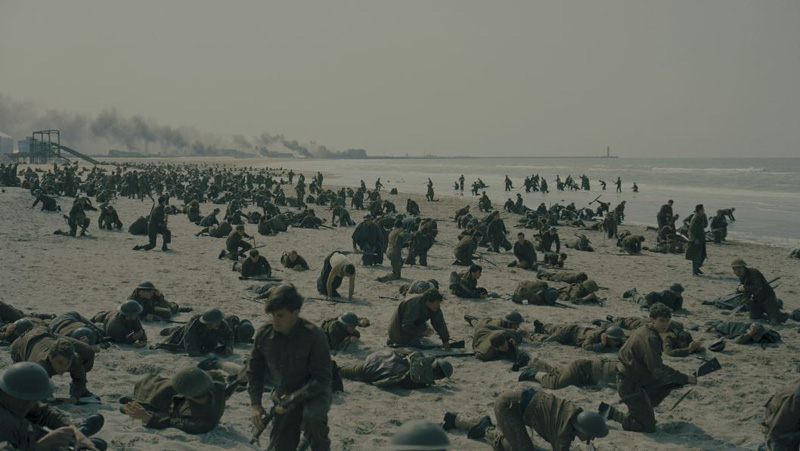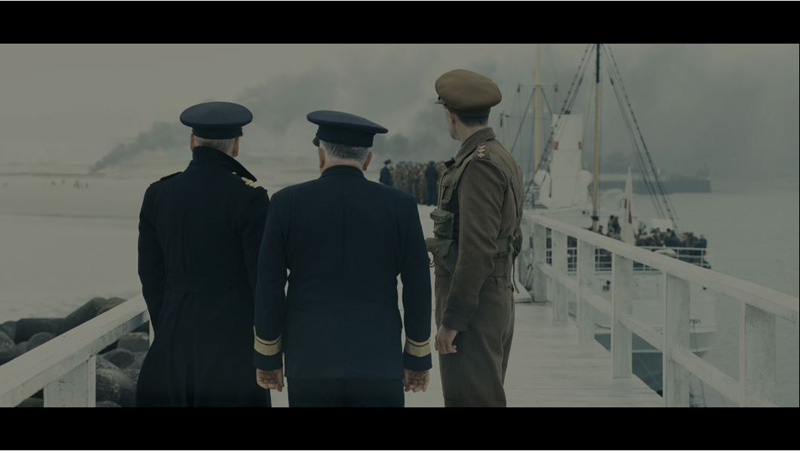|
|
This topic comprises 2 pages: 1 2
|
|
Author
|
Topic: "Dunkirk" - BD has been panned and scanned!
|
Leo Enticknap
Film God

Posts: 7474
From: Loma Linda, CA
Registered: Jul 2000
|
 posted 01-04-2019 11:13 PM
posted 01-04-2019 11:13 PM





I never got to see it (all the way through) in the theater - no time - but wanted to, so when my local supermarket was selling the BD for $10, I snagged it.
My jaw almost dropped open when I discovered that they've panned and scanned all but a few shots from 2.20 to 16:9. I thought that barbaric practice had been consigned to the trash can of cinema history with the demise of VHS!
In absolutely tiny print on the sleeve of the BD, it states "16x9 variable 2.2:1 and 1.78:1 (IMAX Sequences)". All but a very few shots are 1.78. Probably about two minutes of footage in total is 2.2:1, but the shots are scattered throughout the movie, and as such are very distracting.
NOTE - I am reproducing the frame grabs below as fair use for the purpose of criticism, per 17 U.S.C. § 107. They are (C) Warner Bros.


I have a serious problem with this. The DCP release was 2.2:1 throughout, as were the 70mm prints, so this is how the vast majority of the theatrical audience saw the movie. Furthermore, the letterboxing of 'scope movies into 16x9 has been the industry standard for consumer releases on DVD, BD and streaming ever since the DVD superseded VHS, and native 16:9 TVs superseded 4:3 ones in the late 1990s/early '00s. This is the first panned and scanned consumer release of a major movie I've encountered since then, and IMHO this is a serious step backwards.
I can only assume that Christopher Nolan made the decision that sensitive panning and scanning was the lesser of two evils, if the alternative is the home viewer looking at half a black screen, and that the few shots that survived uncropped are ones that he decided that he simply couldn't alter without losing vital image information (as in the still above, in which the activity in the water in the background would have been lost if it the frame had been cropped to the three characters). But the interspersed letterboxed shots are an annoying distraction, and a constant reminder to the educated viewer of how much of the rest of the movie is missing.
I truly hope that this doesn't become an industry standard practice.
| IP: Logged
|
|
|
|
|
|
Frank Angel
Film God

Posts: 5305
From: Brooklyn NY USA
Registered: Dec 1999
|
 posted 01-06-2019 10:41 AM
posted 01-06-2019 10:41 AM





Nolan seems to be perfectly happy switching aspect ratios around in a film, at least he does in the IMAX version, annoying as it may be, so it's no wonder that he has no problem doing it on the home release. Perhaps he wants to give the home experience the same annoyance that he gave the IMAX viewers. Whatever the reason, screens without masks just encourage this kind of distracting manipulation. No one sees letterboxing as an error anymore. No masking? That even makes is seem less of an error.
Just recently I had a student in the editing lab come to me saying he wants to know how to he get the movie he is editing have "those bars on top and bottom of the picture." I said, well, if you shot your film in 1.85:1 or 2.39:1, then in your 16:9 display, it would have those bars" it would be be letterboxed. I asked him to show me his original material, which not surprisingly was shot 16:9. So I told him if he composed it and shot it at 16:9, why would you want bars on top an bottom which would only crop his original composition? He said with conviction, "Because it looks more professional with those bars like you see in the movie theatre." I said, if it wasn't shot that way, unless you have a REALLY GOOD REASON, you should leave it in the aspect ratio you originally intended to use. I also mentioned that his professor should have explained aspect ratios to him.
| IP: Logged
|
|
|
|
|
|
Chris Haller
Film Handler
Posts: 68
From: Rochester, NY, USA
Registered: Dec 2015
|
 posted 01-06-2019 03:04 PM
posted 01-06-2019 03:04 PM




I'm going to echo Bobby's sentiments above. The majority of Dunkirk was shot using 15/65 and reframed from the native 1.44:1 IMAX square frame to the standard TV 1.78:1.
There were a select few sequences, mostly concerning the limited dialogue in the film that were shot in standard 5/65 for sync sound. Maybe ten minutes total throughout the entire film were 2.20:1.
Be glad you're seeing the IMAX presentation on home video though. Those few times that they cut to the 5/65 footage in the 15/70 prints of Dunkirk stood right out, worse than any of the 4/35 anamorphic used in Interstellar, The Dark Knight, or the The Dark Knight Rises. It was downright gnarly. Colors shifted, and grain and contrast were all off due to the photochemical processing Nolan insisted on. It was especially bad since Nolan and his team struck those IMAX prints straight off the finished IMAX negative, which made the 15/65 footage an absolute triumph.
I will say however, after seeing a screening in 5/70, that I found it to be an overall improved presentation of the film. It's just so much easier to light a 5/70 print evenly on a large screen than it is to light a 15/70 print on aging, creaking, underfunded IMAX film theater like the one at the Maryland Science Museum. I would imagine most theaters are the same way, due to the fact that they aren't seeing a lot of love for big attractions to draw new customers in.....
| IP: Logged
|
|
|
|
Leo Enticknap
Film God

Posts: 7474
From: Loma Linda, CA
Registered: Jul 2000
|
 posted 01-07-2019 08:22 AM
posted 01-07-2019 08:22 AM





My apologies - I didn't realize that so much of footage was originated on 15/70. That does make a much stronger case for the consumer release being 16:9. I suppose the ultra authentic (to the origination medium) option would have been pillarboxed to 1.4, but that would have either meant brutally panning and scanning the 5/65 originated footage, or going the Grand Budapest Hotel route and changing the matte many times during the movie.
I stick to my guns, though (probably not the best analogy, given the movie's subject matter) - the letterboxed shots interspersed with the full frame (full frame for 1080p, that is) ones were a distraction. Also, the vast majority of the original theatrical audience saw it in 2.20 throughout (the DCP), so I don't think it's unreasonable to have expected that on the BD. Perhaps he could have done what was done with the BD publications of Oklahoma! (2.20 Todd-AO and 2.55 CinemaScope versions both included in a two-disc set) and The Big Trail (Fox Grandeur and 4/35 1.19 versions both included on a two-disc set), and offered both the 2.20 theatrical version in a letterbox, and the optimized for home viewing version.
quote: Mark Gulbrandsen
I'll take the war movies of the 50's 60's and 70's any day over today's crap. Back then they either used the real thing (Battle Of Britain), or cheesy model battle ships that were only on screen 7 seconds three to seven seconds at a time (In Harms Way & Sink The Bismark). The rest of those movies relied on real actors and fine crafts people to make them work well.
Don't forget The Dam Busters, and a certain black Labrador, whose politically incorrect legacy has managed to stop Peter Jackson from remaking it! Though it would be impossible to do such a remake without heavy CGI now. There are enough surviving and airworthy Spitfires to film a squadron of them, but AFAIK, there are only one or two airworthy Lancasters left.
| IP: Logged
|
|
|
|
|
|
|
|
Leo Enticknap
Film God

Posts: 7474
From: Loma Linda, CA
Registered: Jul 2000
|
 posted 01-09-2019 07:56 AM
posted 01-09-2019 07:56 AM





And with that in mind, I suppose that cropping from 1.4 to 1.78 makes sense, because you can simply lose a horizontal slice from the top of the frame.
But IMHO, changing aspect ratios within a movie (or a presentation variant of a movie, as in this case) is a selfish artistic decision that most of the audience won't understand, and even those who do likely won't appreciate it. Back in the '90s, I remember getting constant walkouts during The Horse Whisperer after it went from 1.85 to 'scope, from customers who thought that there was a fault with the equipment, or we'd had something set up wrong, after the black matte suddenly had a picture in it. The Grand Budapest Hotel was just irritating. He should have done the whole show in 1.37 (those compositions suited the subject matter best, IMHO) and left it at that. It was seeing bits of the 2.20 DCP of Dunkirk during service calls that left me with a desire to see it properly (or at least, as close to properly as a 40" TV in the living room, with two cats demanding attention and a toddler waking up every now and again, can achieve), and the letterbox matte coming and going drew my attention away from the acting, directing and cinematography, to wondering what shape the next shot would be in.
| IP: Logged
|
|
Tony Bandiera Jr
Film God

Posts: 3067
From: Moreland Idaho
Registered: Apr 2004
|
 posted 01-09-2019 11:01 AM
posted 01-09-2019 11:01 AM




The same was done with TRON: Legacy throughout the film on BD.
The ONLY time I really noticed the aspect ratio change was in the first one at the beginning of the film, and this was while watching it on the 20' wide screen on a new screening room install.
Bear in mind I was doing a "critical eye" screening while looking for problems or flaws with the CP2210 projector.
Subsequent viewings on my TV's at home...I don't even really notice the changes at all. The movie itself keeps my attention focused (and it doesn't hurt that Garrett Hedlund is hot...) ![[Big Grin]](biggrin.gif)
IMHO if the movie's subject matter is interesting enough, and the overall composition is well done, 99.9% of the viewers will NOT be bothered by (or probably even notice) the aspect ratio changes. (At home that is...in the theatre on a large enough screen, it should have the intended "wow" factor.)
Historically, there is precedent... "The Right Stuff" opens in a 1.37 image, while "Gordo Cooper" does the narration about the early beliefs regarding the sound barrier. The images are riveting, newsreel style black and white, and as the plane impacts the ground, the image jumps to full 'scope AND color.
I used that to my advantage at the Air Force Base Theatre in Tuscon...we had a constant height screen and used the curtains to mask off the sides to good effect... The trailer reel was always 1:85. At the end of that reel, I closed the curtains. I had a short slug of black leader (The good black base film available years ago) spliced onto the end of the reel, with the old trick of "tick" splices for my motor and changeover cues.
During the blackout, I reset the curtains to be just opened at 1:37 when the LADD company logo on the feature hit the screen. Then, as the plane was going down (and the sound was rather loud) I timed the opening of the curtain so that it was almost all the way open when the first frames of the explosion hit. The sound helped to mask the noise from the curtain, so only a very few people even realized that the curtain was moved until AFTER the image got a lot bigger.
And I did ALL of this by hand (and foot for the changeover buttons) as the theatre was never automated.
Oh, and this was happening during my third month as a projectionist. The Air Force division two-star general was so impressed by this, that he came into the booth after the show (I was an E-3 enlisted man) to meet and thank me.
After that, he used to call the theatre and if I was not working, he wouldn't come to the shows. I even did a few private screenings for him and his staff (which was unheard of back then.)
| IP: Logged
|
|
|
|
|
|
All times are Central (GMT -6:00)
|
This topic comprises 2 pages: 1 2
|
Powered by Infopop Corporation
UBB.classicTM
6.3.1.2
The Film-Tech Forums are designed for various members related to the cinema industry to express their opinions, viewpoints and testimonials on various products, services and events based upon speculation, personal knowledge and factual information through use, therefore all views represented here allow no liability upon the publishers of this web site and the owners of said views assume no liability for any ill will resulting from these postings. The posts made here are for educational as well as entertainment purposes and as such anyone viewing this portion of the website must accept these views as statements of the author of that opinion
and agrees to release the authors from any and all liability.
|

 Home
Home
 Products
Products
 Store
Store
 Forum
Forum
 Warehouse
Warehouse
 Contact Us
Contact Us




 Printer-friendly view of this topic
Printer-friendly view of this topic











![[Big Grin]](biggrin.gif)



